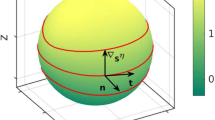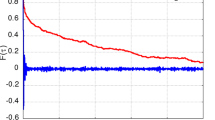Abstract
Dynamic simulation of grain boundary migration in two dimensions requires the combined movement of grain boundaries and three-junctions. In this work, a method of dynamic simulation is described where the migration is broken down into two steps: I. The grain boundaries migrate with frozen threejunctions. II. The three-junctions are released in order to obtain equilibrium. In principle, the development of any initial two-dimensional grain-structure can be studied. The CPU-time and memory requirements increase with increasing number of grains.
Similar content being viewed by others
References
Abbruzzese, G., and Lücke, K. (1986). A theory of texture controlled grain growth—I. Derivation and general discussion of the model,Acta Metall. 34, 905–914.
Beck, P. A. (1952). Interface migration in recrystallization, inMetal Interfaces, American Society for Metals, Cleveland, pp. 208–247.
Burke, J. E. (1949). Some factors affecting the rate of grain growth in metals,Trans. AIME 180, 73–91.
Feltham, P. (1957). Grain growth in metals,Acta Metall. 5, 97–105.
Fradkov, V. E., Schvindlerman, L. S., and Udler, D. G. (1985). Computer simulation of grain growth in two dimensions,Scripta Metall. 19, 1285–1290.
Hillert, M. (1965). On the theory of normal and abnormal grain growth,Acta Metall. 13, 227–238.
Johnson, L. W., and Riess, R. D. (1982).Numerical Analysis, Addison-Wesley, Reading, Massachusetts.
Kershaw, D. (1982). Solution of single tridiagonal linear systems and vectorization of the ICCG algorithm on the Cray-1, in Rodrique, G. (ed.),Parallel Computations, Academic Press, New York, pp. 85–99.
Kurtz, S. K., and Carpay, F. M. A. (1980). Microstructure and normal grain growth in metals and ceramics. Part I. Theory.J. Appl. Phys. 51(11), 5725–5744.
Louat, N. P. (1974). On the theory of normal grain growth,Acta Metall. 22, 721–724.
Mullins, W. W. (1956). Two-dimensional motion of idealized grain boundaries,J. Appl. Phys. 27, 900–904.
Prenter, P. M. (1975).Splines and Variational Methods, John Wiley & Sons, New York.
Schoenberg, I. J. (1946). Contributions to the problem of approximation of equidistant data by analytic functions,Q. Appl. Math. 4, 45–99, 112–141.
Smith, C. S. (1948). Grains, phases and interfaces: An interpretation of microstructure,Trans. AIME 175, 15–51.
Author information
Authors and Affiliations
Rights and permissions
About this article
Cite this article
Saetre, T.O., Ryum, N. Dynamic simulation of grain boundary migration. J Sci Comput 3, 189–199 (1988). https://doi.org/10.1007/BF01061257
Received:
Issue Date:
DOI: https://doi.org/10.1007/BF01061257




